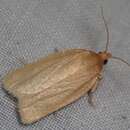Conservation Status
University of Alberta Museums tarafından sağlandı
Probably of no concern, a minor pest in some areas.
- lisans
- cc-by-nc
- telif hakkı
- University of Alberta Museums
Cyclicity
University of Alberta Museums tarafından sağlandı
Early July to early August in Alberta, mid June to late August elsewhere.
- lisans
- cc-by-nc
- telif hakkı
- University of Alberta Museums
Distribution
University of Alberta Museums tarafından sağlandı
From British Columbia to Quebec, south to Florida and California.
- lisans
- cc-by-nc
- telif hakkı
- University of Alberta Museums
General Description
University of Alberta Museums tarafından sağlandı
"The forewing is light straw-yellow usually with some slightly darker shading along the outer margin and a pale fringe. There is some sexual dimorphism, with females typically having a slightly narrower forewing. The hindwing is light grey with white along the costa and a white fringe. Overall it is similar to the much more frequently encountered Clepsis clemensiana, however X. pallorana lacks a costal fold in the male.
The larva is yellowish green with a dark spot in the eyes. (Chapman & Lienk 1971)
The pupa is strikingly bicolored with the dorsal half dark green and blackish while the ventral portion is greenish ivory. (Chapman & Lienk 1971)"
- lisans
- cc-by-nc
- telif hakkı
- University of Alberta Museums
Habitat
University of Alberta Museums tarafından sağlandı
Open habitiats.
- lisans
- cc-by-nc
- telif hakkı
- University of Alberta Museums
Life Cycle
University of Alberta Museums tarafından sağlandı
The larva hibernates in a mid-instar inside a folded leaf, resuming feeding in the springtime and pupating on the host plant. The larva feeds by tieing leaves and flowers of its host plant together. (Chapman & Lienk 1971; MacKay 1962)
- lisans
- cc-by-nc
- telif hakkı
- University of Alberta Museums
Trophic Strategy
University of Alberta Museums tarafından sağlandı
The larva feeds primarily on legumes like Alfalfa (Medicago sativa) and White Sweet Clover (Melilotus alba), though while wandering can defoliate a variety of other plants including pine seedlings. (Chapman & Lienk 1971)
- lisans
- cc-by-nc
- telif hakkı
- University of Alberta Museums
Xenotemna pallorana
(
Fransızca
)
wikipedia FR tarafından sağlandı
Xenotemna pallorana est une espèce nord-américaine de lépidoptères (papillons) de la famille des Epermeniidae. Elle est l'unique représentante du genre monotypique Xenotemna.
Description
L'imago a une longueur de l'aile antérieure (LAA) de 8,5 à 14 mm. La couleur des ailes antérieures varie du jaune pâle au crème ou au brun clair. Les ailes postérieures sont gris brunâtre et blanches ou jaunâtres.
La chenille mesure plus de 20 mm[1].
Répartition
On trouve Xenotemna pallorana en Amérique du Nord, de l'Alaska à la Californie, vers l'est jusqu'à la Floride, au Québec et à l'Ontario[1].
Écologie
L'espèce produit deux générations par an, et les adultes volent de mai à août. L'espèce passe l'hiver sous forme de chenille à mi-stade larvaire, et la nymphose a lieu dans le site d'alimentation final des chenilles.
La chenille mine les feuilles de sa plante hôte. Elle se nourrit des Aster, Erigeron annuus, Silphium, Solidago, Symphyotrichum novae-angliae, Hypericum perforatum, Medicago sativa[1], Melilotus officinalis, Trifolium, Monarda fistulosa, Picea glauca, Pinus banksiana, Pinus resinosa, Pinus strobus, Pinus sylvestris, Fragaria, Malus, Prunus pumila, Prunus serotina, Prunus virginiana, Rosa, Comandra umbellata, Ulmus et Verbena.
Notes et références
-
(en) Cet article est partiellement ou en totalité issu de l’article de Wikipédia en anglais intitulé .
- lisans
- cc-by-sa-3.0
- telif hakkı
- Auteurs et éditeurs de Wikipedia
Xenotemna pallorana: Brief Summary
(
Fransızca
)
wikipedia FR tarafından sağlandı
Xenotemna pallorana est une espèce nord-américaine de lépidoptères (papillons) de la famille des Epermeniidae. Elle est l'unique représentante du genre monotypique Xenotemna.
- lisans
- cc-by-sa-3.0
- telif hakkı
- Auteurs et éditeurs de Wikipedia
Xenotemna pallorana
(
Felemenkçe; Flemish
)
wikipedia NL tarafından sağlandı
Insecten Xenotemna pallorana is een vlinder uit de familie van de bladrollers (Tortricidae).[1] De wetenschappelijke naam van de soort is voor het eerst geldig gepubliceerd in 1869 door Robinson.
Bronnen, noten en/of referenties Geplaatst op:
06-04-2013
Dit artikel is een beginnetje over biologie. U wordt uitgenodigd om op bewerken te klikken om uw kennis aan dit artikel toe te voegen.

- lisans
- cc-by-sa-3.0
- telif hakkı
- Wikipedia-auteurs en -editors

